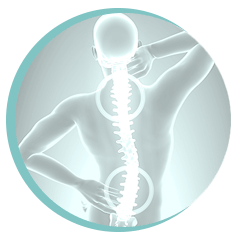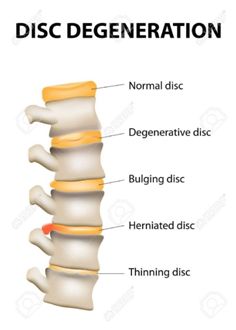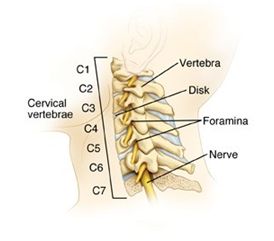
Back and neck pain
Lower back pain
Lower back pain is one of the most common conditions seen in musculoskeletal physiotherapy and it accounts for the largest cause of work-related absence.

Lower back pain can be caused by an injury such as a sprain or strain, but often it’s not possible to identify the cause. This is known as ‘non-specific’ back pain.In ‘mechanical’ back pain, structures which may contribute to your back symptoms are the joints, discs, muscles and nerves. One of the common causes of lower back pain is aslipped or prolapsed disc. A slipped disc occurs when there is a tear in the outer layer of the intervertebral disc, resulting in the inner gel escaping outwards. If the protruding gel meets the adjacent nerve, it can cause pain in the lower back as well as a referral into the leg. This is known as sciatica. It may also cause additional symptoms such as numbness or a tingling sensation.
Research has shown that early physiotherapy reduces the incidence of back surgery and is the most effective form of treatment for lower back pain.
How can we help with lower back pain?
Your physiotherapist may use some of the following physiotherapy techniques:
- specific spinal mobilisations
- release tight muscles
- Give you a bespoke exercise programme which may include mobilising exercises for the back and nerve, as well as pilates and strengthening of any other muscles which are lacking strength or control.
- Acupuncture
- Taping
The aim of our treatment is to aid your recovery, so you are pain-free and back to your normal activities.
07495 834716
CALL US
Neck pain
Neck pain is a common condition which physiotherapists can help you with. Neck pain can have several causes including a muscle strain, sitting or sleeping in a poor position for an extended period, whiplash and osteoarthritis. It can also be caused by or worsened by stress and anxiety. Occasionally a disc protrusion can irritate the adjacent nerve, causing a ‘pinched or trapped nerve’ or cervical radiculopathy.
Osteoarthritis or cervical spondylosis occurs naturally with age. It is also known as ‘wear and tear’. Though it is not always symptomatic, it can lead to neck stiffness and pain.
Whiplash occurs when the body is thrown in a forceful jerk, causing the sudden movement of the head forwards, backwards or sideways. It overstretches and strains the soft tissue in the neck and most commonly occurs in road traffic accidents. It can lead to neck pain and tenderness, headaches and stiffness. Pins and needles or numbness can also occur in the arm.

Cervical radiculopathy or a ‘trapped nerve’ is pain caused by irritation or compression of one of the nerves in the neck. It often causes pain down the arm and can sometimes cause pins and needles, numbness and, less commonly, weakness in the affected arm. It is usually caused by a protruding intervertebral disc bulging outwards on to a nearby nerve or inflammation in the vicinity of the nerve root.
Physiotherapy and exercise can alleviate neck pain and improve mobility. We may use the following physiotherapy techniques in your treatment plan: cervical and thoracic spine mobilisations, release tight muscles, mobilising exercises for the neck and upper back, gliding exercises for the nerve, strengthening exercises of any muscles which are lacking strength or control, acupuncture, taping.
